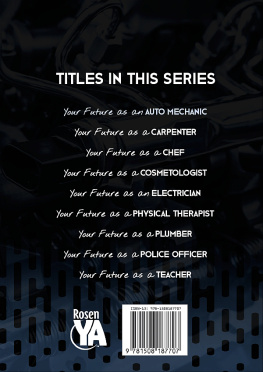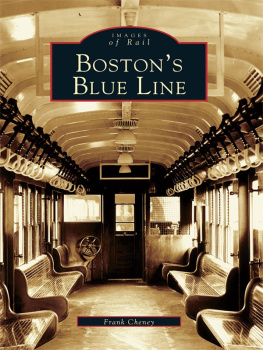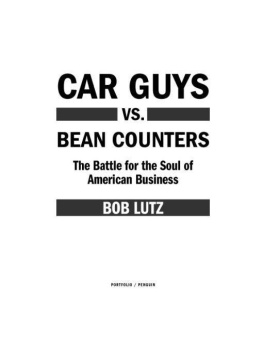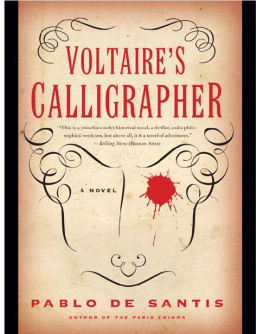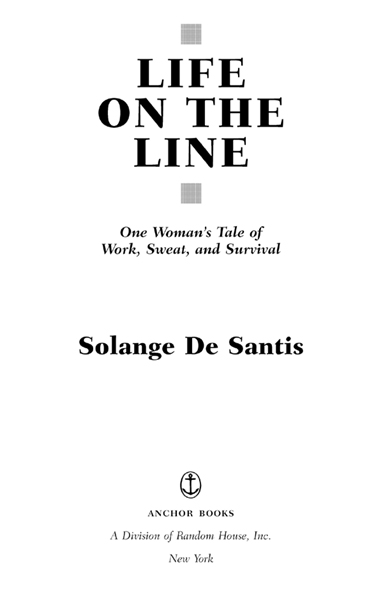Solange De Santis
LIFE ON THE LINE
Solange De Santis has been a reporter and writer for The Palm Beach Post, Reuters, the Associated Press, The Globe and Mail (Toronto), and The Wall Street Journal. This is her first book. She is currently a freelance writer living in Toronto.
Copyright 1999 by Solange De Santis
All rights reserved under International and Pan-American Copyright Conventions.
Published in the United States by Anchor Books,
a division of Random House, Inc., New York.
Originally published in hardcover in the United States by Doubleday,
a division of Random House, Inc., New York, in 1999 .
Anchor Books and colophon are registered trademarks of Random House, Inc.
Lines from Black Dog by Jimmy Page, Robert Plant,
and John Paul Jones copyright 1972 Superhype Publishing.
All Rights Administered by WB Music Corp.
All Rights Reserved. Used by Permission of
Warner Bros. Publications U.S., Inc., Miami, FL 33014 .
The Library of Congress has cataloged the Doubleday edition as follows:
De Santis, Solange.
Life on the line: one womans tale of work, sweat, and
survival / by Solange De Santis.
p. cm.
I. De Santis, Solange. 2. Woman automobile industry
workersOntarioScarborough. 3. General Motors of
CanadaEmployees
I. Title.
HD6073.A82C23 1999
331.48292092dc21
[b] 98-51974
eISBN: 978-0-307-78799-6
www.anchorbooks.com
v3.1
To my mother, Florence Stevenson De Santis:
teacher, mentor, scholar, leader.
What fun we had.

ACKNOWLEDGMENTS
A lthough this book is dedicated to my mother, my father, Arthur A. De Santis, has had an equally profound effect upon my life. From my father, I learned that a man can truly love and admire a strong woman and never lose any of his own power. I sawand continue to seea life grounded in common sense, lived with eloquence and style.
My brother, Arthur L. De Santis, has been a source of support and friendship. His adventurous spirit is a constant inspiration. My husband, Camille G. Peters, raised an eyebrow when he realized he was going to appear in a book. I hope the results do not embarrass him too much and thank him for his graceful forbearance. My daughter, Florence De Santis Peters, showed excellent timing. Her arrival allowed me to combine maternity leave with book writing.
This book would still be a vague thought were it not for Jan Whitford of Westwood Creative Artists, who inexplicably stayed with this project for years and whose counsel I value. Peternelle van Arsdale of Doubleday in New York, with patience and wisdom, guided the material into its final form. I am grateful also to John Pearce and Pamela Murray of Doubleday Canada for their support.
Many people at General Motors shared their lives, experiences, and opinions with me. Names and identifying details have been changed, but I wish to express special thanks to: Bill Skinner, Dan Aleksich, Darlene Bond, Eric Dowling, and Gayle Hurmuses.

CONTENTS

PROLOGUE
Through a Windshield, Darkly
I ts late Friday night at the end of a long, hot summer week. Many of the good citizens of Toronto are settling in to watch the eleven-oclock news, or climbing into bed, or leaving a bar. In the Trim 2 department of General Motors Corporations Scarborough Van Plant, its very quiet on the 5 P.M . to 1 A.M . shift, a purely relative concept considering the robotic racket from the body shop. But the rhythms seem muted tonight, muffled by air hanging heavy as a steel curtain.
The line hasnt gone down onceautomatically the high point of any shift. Boxy vans glide through the plant, dragged by the squeaky assembly-line chain, inexorable as death. Weve seen our supervisor, Lance, just once, at the beginning of the evening. No union reps, no fights, no company bulletins, no nothingjust us and our jobs.
After a week of stifling days, every single piece of machinery in the plant seems to radiate heat. Some folks space out, daydreaming, while literally going through the motions, waiting for the shift to end, waiting to be released into the cooler night. A big yellow floor fan near my workstation is whirring, trying to be helpful. As I finish a van, I step up to it, close my eyes, and let the warm breeze cool my flushed face a little. Thank God for this fan. I love this fan. It is the most important object in the world right now.
Im installing windows on the passenger side of the vansboth the big window that you, Mr. or Ms. Van Passenger, roll down and the smaller window that you push outward. As they crawl by, painted but only half assembled, I pick up a triangular small-window assembly in my left hand and the main window in my right. They weigh a couple of pounds apiece. I walk around the vans open door and rest the small window, called a c.v. for some reason, against the steel skeleton of what will be the dashboard.
I slide the larger window down into the door and jam its bottom bracket onto the regulator, the X-shaped device that raises and lowers the window. Then I fit a black rubber window liner into the c.v. bracket and shove the c.v. into place next to the main window. I push the rest of the black liner around the main window frame. If youre short, like me, you shove it with your arms over your head. You do this two hundred times a day.
As I push on the liner, feeling my neck and shoulders ache, my heat-soggy dreaminess is interrupted. I spot one of the trainers in our department, Barry Harvey, and his buddy, forklift driver Monty Allen, tiptoeing behind the parts racks across the aisle with a Y-shaped piece of wood and a bag of water balloons.
They have constructed a truly magnificent weapon, a slingshot made of wood and rubber tubing thats so big one man holds the ends above his head and the other pulls back the cradle. Had Barry and Monty been medieval arms merchants, they would have had offers from every lord in Europe.
They have checked the aisle. Not a supervisor in sight. They are loading the siege engine. Monty is kneeling in the aisle, arms up, holding the ends. Barry is pulling back the rubber. They are aiming directly at me.
Now, wait a minute, you guys! I yell. Yipes! I duck behind the door of a van as a water balloon explodes off the window-subassembly machine next to the line, spray flying. Ha! Missed me! Another van is up to my station, so I have to abandon my cover and move into the open to heft the glass.
The saboteurs, who have had a liquid lunch in the parking lot, slink down the aisle, so I have to install the windows facing down the line, yet I glance nervously over my shoulder every few seconds. From roughly forty feet away, the balloons become flying bombs.
I look away from the ballistics crew to pay attention to my windows andwhongggg!I hear the sound of a launch. Blonk! A loud clunk from behind me, but no spray. What the hey I check the next van, a nifty dark-blue number, and notice a distinct dent in the lower passenger-side door. Upon further search, the water balloon, which is not broken, is found under a garbage bin.


